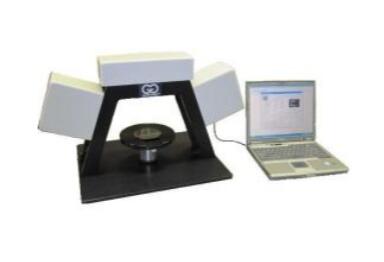
LSE-2A2W Ellipsometer specifications
Alignment: | Tilt and table height using computer alignment screen. |
Incidence Angles: | fixed at 60° for 544nm laser and 70° for 633nm laser |
Method of Measurement: | Advanced StokesMeter determines the complete measuring beam polarization using no moving parts and no modulators, only 4 stationary silicon detectors so measurements are stable and exact. |
Measurement Time: | Partically instantanious |
Measuring Laser: | 544 & 633 nm HeNe Gas Lasers with 1 mm measuring beam diameter |
Alignment Laser: | 670nm Laser Diode |
Sample (Wafer) Size: | 300 mm wide X unlimited length |
Stage: | Hand positioning with tilt and table height adjustment. |
Software: | Windows LGEMP4 layer absorbing included. |
Required Computer: | (not included) Windows PC or laptop with USB port |
Film Thickness Range: | 0 - 60,000 Angstroms on substrate or on 1, 2, 3, or 4 known sublayers. |
Precision, Repeatability: | Sub-Angstrom over most of the measurement range. |
Refractive Index: | ± .001 over most of the measurement range. |
Power: | Supplied by computer USB bus and laser power supplies. |
Dimensions: | Height: 16.5 Width: 27.5 Depth: 16 inches |
CDRH Compliance: | All laser ellipsometers supplied by Gaertner comply with CDRH requirements 21CFR 1040 for a Class II laser product emitting less than 1 mW or Class IIIb less than 5 mW of low power radiation. As with any bright source such as the sun or arc lamp, the operator should not stare directly into the laser beam or into its reflection from highly reflecting surfaces. |
CE Compliance: | Comply with European safety directives and carry the CE mark. |
Manufactured by Gaertner Scientific, USA
Stokes Ellipsometer LSE Description
The Stokes Ellipsometer LSE is a continuation of an entirely new line of ellipsometers based on the advanced StokesMeter technology - winner of Photonics Spectra and R&D 100 best new products awards.
The LSE model ellipsometer includes data acquisition and analysis software. An optional Windows based computer with PCI interface is available.
This ellipsometer uses patented StokesMeter technology with no moving parts and no modulators to quickly and accurately determine the complete polarization state of the 6328Å laser measuring beam at a 70° incidence angle. The space-saving design features a small footprint yet it can accommodate large samples up to 300mm wide. The sample stage can be easily moved by hand to measure any point on the sample surface. The sample table includes a manual tilt and table height adjustment which is set using an alignment screen on the computer.
The data acquisition and analysis software, LGEMP, can measure the top layer film thickness and film refractive index on a substrate or on 1, 2, or 3 known bottom layers. The films can be transparent or absorbing. This durable integration of hardware and software is fast and easy to use.
Extremely precise, stable and low cost the model LSE Stokes Ellipsometer represents an excellent value in a basic ellipsometer.
Description of Stokesmeter Technology
This patented device uses no moving parts and no modulators to quickly and accurately determine the complete polarization state of the measuring beam.
The diagram above shows the StokesMeter photopolarimeter for the simultaneous measurement of all four Stokes parameters of light. The light beam, the state of polarization of which is to be determined, strikes, at oblique angles of incidence, three photodetector surfaces in succession, each of which is partially spectrally reflecting and each of which generates an electrical signal proportional to the fraction of the radiation it absorbs. A fourth photodetector is substantially totally light absorptive and detects the remainder of the light. The four outputs thus developed form a 4x1 signal vector I which is linearly related, I=AS, to the input Stokes vector S. Consequently, S is obtained by S=A(-1)I. The 4x4 instrument matrix A must be nonsingular, which requires that the planes of incidence for the first three detector surfaces are all different. For a given arrangement of four detectors, A can either be computed or determined by calibration.
Technological Advantage
The clean, compact StokesMeter replaces a typical rotating analyzer assembly consisting of a drum, prism, encoders, switches, motor and detector and their associated electronics. In addition, the waveplate mechanism on the polarizer arm, is eliminated. This results in a fast, precise, stable no moving parts ellipsometer.
An outstanding feature is the Stokes Ellipsometer's compensation for small changes in angular beam deviation caused by sample out-of-flatness. This permits fast, uninterrupted measurement over the entire wafer surface without the need to pause to correct for focus and tilt. When scanning similar samples, tilt-free, focus-free operation is the obvious benefit.